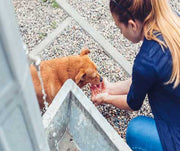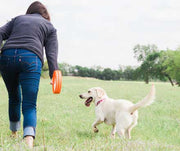Separation Anxiety

Separation anxiety for dogs typically occurs in the first 20-30 minutes that you leave your dog alone. An easy solution to help your dog develop a positive association with being left alone is dog toys or other accessories from Petmate. From mazes and puzzles to treat balls, Petmate carries a wide selection of dog treat toys to keep your pup busy and engaged while you're away. If your furry friend is still a puppy, puppy-proofing your home with the proper essentials can also help to combat separation anxiety.
DO YOU WONDER IF YOUR DOG HAS SEPARATION ANXIETY?
For a long time, scientists have been trying to pinpoint exactly why dogs or cats have separation anxiety. So far, they've learned that animals that grow up in the same household their whole life are much less likely to suffer from separation anxiety. However, if an animal has been relocated or adopted, they are more likely to develop anxiety.
If your dog whines, paces, barks, "talks, or does anything out of the ordinary right before you leave, your dog may have separation anxiety. A few ways to help distract from the anxiety is to provide plush toys for them to cuddle with, treat toys for them to maul, or even leave the TV on the Dog TV Channel (yes, a TV channel for dogs is real). These are just a few helpful distraction techniques that you can try with your puppy if they are showing signs of separation anxiety.
SHOULD I CRATE-TRAIN MY DOG IF THEY SUFFER FROM ANXIETY?
There are a lot of different views on this topic. Most people would not hesitate in saying, "Yes! Crate training is the best thing you can do!". While this is oftentimes correct, for some animals it can intensify anxiety. If you have a puppy, you'll have more success at crate training vs. crate training an older dog. If puppies are crate trained while they're young, they will see their crate as a safe place and go there to relax when you are not home. However, if you've rescued an older dog or have an older dog, and they've never been crate trained, you're less likely to succeed. For older dogs who do suffer from separation anxiety, you can always put a cozy plastic kennel in your living area, with a cozy bed or blanket inside, and leave the door open. Give your dog some time to warm up to it. Over time, that will become is safe place to go to when you are not home.
OTHER WAYS TO REDUCE YOUR DOG'S ANXIETY
One of the easiest ways to slowly tick away at your animal's separation anxiety is to desensitize its stress with pre-departure cues. This means, your dog will know that when you grab your keys, it's time for you to go, and their anxiety will spike out of nowhere. They may whine, pace, cry or even scratch the door after you close it to try to get to you. This type of behavior is what you will target over the next few weeks. The way you desensitize your pet is to simply do these pre-departure cues multiple times throughout the day, but not leave. In the beginning, your pet will be very confused, however, eventually, they will understand that just because you grab your keys, doesn't mean that you will leave. This shows them that leaving after you grab your keys is not always a constant factor and they may stay.
One of the best exercises is to work on the actual departure:
1. Open the door then close it.
2. Open the door and walk out and walk back in after 10 seconds.
3. Open the door and walk out and walk back in after 1 minute.
4. Open the door and walk out and walk back in after 3 minutes.
5. Continue up until your pet can go calmly for an hour without your presence.
This will most definitely take some time in order to have a permanent effect. However, if you reward the positive behavior with a treat every time you come back in the room, your dog will quickly get the hang of it.
They will begin to understand that you will come back when you leave and calm down over time. This is by no means a fast process. It requires patience and time. Once your pet shows signs of improvement, you can scale down on the desensitizing process and focus on bonding with your pet.
WHAT IF THAT DOESN'T HELP?
If nothing is helping, it's time to bring out the big guns and try the Petmate Calmz Anxiety Relief System. This anxiety device for dogs combines high-tech innovation with acupressure in a revolutionary, non-invasive, drug-free treatment, that soothes anxiety that often arises as a result of thunderstorms, fireworks, encounters with strangers, being alone, travel, and loud noises. This innovative system is complete with an adjustable Custom Fit Vest that cradles a device over specific acupressure points on your dog's spine. When the device is activated, the clinically proven NeuroSync Technology takes over. Your dog will hear and feel a therapeutic blend of classical music, tones, and vibrations to ease anxiety.
The Calmz Anxiety Relief System will help further the desensitization process and speed up helping your dog with their anxiety. Sometimes, all you need is that extra "oomph" that can push the training where you need it to be.
ARE MY ACTIONS CAUSING THE ANXIETY?
You may not like this answer, but you might be encouraging this separation anxiety behavior without knowing it. If your pet is whining in fear of you leaving, and you comfort and cuddle it, you are rewarding this behavior. Focus on cuddling and loving your pet when you're home, spending time together.
Sources:
Previous article

Next article

Related posts
View all-

What Can You Use Instead of Cat Litter?
Traditional cat litter is convenient, but it’s not the only option. Many cat owners look for alternatives to reduce waste, save money, or avoid chemicals found in clay-based kitty litter. Some options offer better odor control, while others are more eco-friendly or gentler on a cat’s paws.
Read Article -

How to Keep My Backyard Smelling Fresh
A clean backyard should smell fresh, unlike pet waste, smoke, or mold. Bad smells can linger, especially when dog poop, urine, or food scraps attract flies and bacteria. If your yard has a foul odor, it's time to take action. The first step is cleaning up pet feces, trash, or rotting food. A garden hose can wash away dirt and urine from artificial turf, patios, and decks. To neutralize odor, Use baking soda, white vinegar, and essential oils.
Read Article -

What Supplies Do First-Time Cat Owners Need?
Bringing home a new cat is exciting, but making them feel safe and comfortable takes more than love. First-time cat owners must prepare with the right supplies to ensure a smooth transition. From a litter box to cat food and a warm bed, having the basics ready can help your new kitty settle in faster. This guide covers everything a new cat owner needs to make their new pet feel at home.
Read Article



